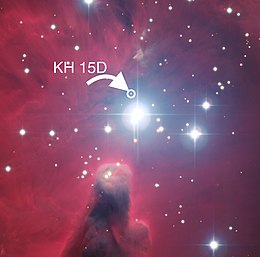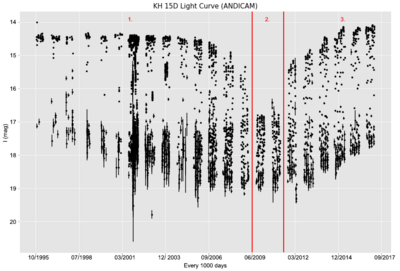KH 15D
KH 15D (V582 Monocerotis), described as a winking star because of its unusual dips in brightness,[11] is a binary T Tauri star system embedded in a circumbinary disk. It is a member of the young open cluster NGC 2264, located about 2,500 light-years (770 pc) from the Sun in the constellation of Monoceros.
Discovery
[edit]The unique brightness variations of KH 15D were discovered at Wesleyan University's Van Vleck Observatory in 1995 by Dr. William Herbst and his then-master's student Kristin Kearns.[12] The star was found to alternate, on a 48.37-day period[3] between a brighter "on" state and a fainter "off" state that was less than 4% of the bright state (or up to 96% dimmed). As the years went by, the star spent more and more time "off", such that by 2010 it was always in the faint state, although still periodically variable. In 2012 it unexpectedly began to "wink" on and off again and has now entered a phase where its "on" state is almost twice as bright as it was in the mid-1990s (see light curve).
Hypotheses
[edit]A consensus model of this puzzling behavior has emerged, which attributes the winking to the rising and setting of one star relative to the edge of a circumbinary ring that occults part of the orbit.[13][14][15][16] Precession of the ring has caused the gradual evolution of the winking behavior as shown in the diagrams below. Radial velocity measurements confirmed the system as a spectroscopic binary[17] composed of two weak-lined T Tauri stars.[18]
The orbit of the binary system is nearly edge-on to our line of sight and the circumbinary disk is tilted with respect to that orbit, resulting in nodal precession. At the time of the 1996 observation only one star (designated star A) was visible while the occulting ring fully blocked the light from star B. The winking observed was caused by star A rising and setting from behind the ring. By 2010, the ring covered both stars and the system was permanently in the "off" state, being seen only by scattered light off the ring. By 2018, star B was fully uncovered and star A fully occulted. Star B has turned out to be somewhat brighter, hotter and more massive than star A, but the labels have not been changed since this might cause confusion in the literature.[19][20][21][22]
The importance of KH 15D derives from the unique opportunity it provides to study the terrestrial planet formation zone of a protoplanetary disk. From its rate of precession it is known that the occulting ring is located about 3 AU from the stars,[9] which would put it at the asteroid belt in the Solar System. The age of KH 15D is around 3 Myr and its total mass is around 1.5 solar masses,[4] so the system may provide some guidance on when and how planetesimals – the precursors of planets such as the Earth – form. The regular occultations also provide opportunities to study the magnetospheres and photospheres of T Tauri stars in unprecedented detail.[9]
The Disk
[edit]Composition
[edit]Though the composition of the disk is not known for sure, there has been evidence of methane and water ice features with grain sizes of 1-50 μm.[23]
Bipolar outflows
[edit]It has also been observed that there are bipolar outflow jets inclined by 84% coming from the disk itself.[18] Both hydrogen and carbon dioxide outflows have been observed extending from the north and south sides of the disk.[4] These observations have led to an upper mass limit of 3.2266e27 kg for the disk.
Gallery
[edit]-
The "advancing screen", as represented by the gray screen, moves across the binary orbit of Star B (blue circle) and Star A (red circle) in the direction of the arrows at a speed of 15 m/s. In the top left image, both of the stars are unobscured by the circumbinary ring. In the top right image, the screen fully occults the orbit of Star B, and part of star A's orbit. This allows Star A to "rise" and "set", or appear to be "winking". The bottom left shows the screen block both orbits, which occurred in 2010 until 2012. The bottom right shows the current state of the system, the orbit of Star A is occulted while Star B "rises" and "sets", as Star A previously did. Other visual representations could be found in the following papers: Winn et al. 2006,[9] Capelo et al. 2012,[5] Arulanantham et al. 2017,[23] and the one that inspired this image, Aronow et al. 2018.[4]
-
This graph shows the brightness over time for the KH 15D System. When both stars appear (not shown here) the system is brightest, and when neither star appears, the system is dimmest. The numbers represent different stages of the system: 1. Star A "rises" and "sets", while the disk occults Star B. Thus, most of the brightness comes from Star A. 2. Both Star A and B are occulted, but instead of a reading of zero magnitudes the scattered light is seen. 3. Star B "rises" and "sets", while the disk occults Star A, so most of the brightness is from Star B. From the light curve, Star B is brighter than Star A, marking it the primary star.
See also
[edit]References
[edit]- ^ a b Dahm, S. E.; et al. (2005). "The T Tauri Star Population of the Young Cluster NGC 2264". The Astronomical Journal. 129 (2): 829. Bibcode:2005AJ....129..829D. doi:10.1086/426326.
- ^ "V582 Monocerotis". The International Variable Star Index. American Association of Variable Star Observers. Retrieved 29 June 2018.
- ^ a b c Hamilton, Catrina M.; et al. (2001). "Eclipses by a Circumstellar Dust Feature in the Pre-main-Sequence Star KH 15D". The Astronomical Journal. 554 (2): L201 – L204. arXiv:astro-ph/0105412. Bibcode:2001ApJ...554L.201H. doi:10.1086/321707. S2CID 17956137.
- ^ a b c d e f g h i j k l m n o p q r s t u v w Aronow, Rachel A.; et al. (2018). "Optical and Radio Observations of the T Tauri Binary KH 15D (V582 Mon): Stellar Properties, Disk Mass Limit, and Discovery of a CO Outflow". The Astronomical Journal. 155 (1): 47. arXiv:1711.11434. Bibcode:2018AJ....155...47A. doi:10.3847/1538-3881/aa9ed7. S2CID 59444726.
- ^ a b Capelo, Holly L.; et al. (2012). "Locating the Trailing Edge of the Circumbinary Ring in the KH 15D System". The Astrophysical Journal Letters. 757 (1): L18. arXiv:1208.5497. Bibcode:2012ApJ...757L..18C. doi:10.1088/2041-8205/757/1/L18. S2CID 51004072.
- ^ a b Prusti, T.; et al. (2016). "The Gaia mission". Astronomy & Astrophysics. 595: A1. arXiv:1609.04153. Bibcode:2016A&A...595A...1G. doi:10.1051/0004-6361/201629272. S2CID 9271090.
- ^ a b Brown, A. G. A.; et al. (Gaia collaboration) (August 2018). "Gaia Data Release 2: Summary of the contents and survey properties". Astronomy & Astrophysics. 616. A1. arXiv:1804.09365. Bibcode:2018A&A...616A...1G. doi:10.1051/0004-6361/201833051. Gaia DR2 record for this source at VizieR.
- ^ a b Bailer-Jones, C. A. L.; et al. (April 2018). "Estimating distances from parallaxes IV: Distances to 1.33 billion stars in Gaia Data Release 2". The Astronomical Journal. 156 (2): 58. arXiv:1804.10121. Bibcode:2018AJ....156...58B. doi:10.3847/1538-3881/aacb21. S2CID 119289017.
- ^ a b c d e f Winn, Joshua N.; et al. (2006). "The Orbit and Occultations of KH 15D". The Astronomical Journal. 644 (1): 510–524. arXiv:astro-ph/0602352. Bibcode:2006ApJ...644..510W. doi:10.1086/503417. S2CID 3243843.
- ^ "V582 Mon". SIMBAD. Centre de données astronomiques de Strasbourg. Retrieved 25 June 2018. — some of the data is located under "Measurements".
- ^ Wilford, John Noble (20 June 2002). "Star's 'Wink' May Be Clue To Creation of Planets". The New York Times. Retrieved 26 June 2018.
- ^ Kearns, Kristin E.; et al. (1998). "Additional Periodic Variables in NGC 2264". The Astronomical Journal. 116 (1): 261–265. Bibcode:1998AJ....116..261K. doi:10.1086/300426. S2CID 122920025.
- ^ Winn, Joshua N.; et al. (2004). "KH 15D: Gradual Occultation of a Pre-Main-Sequence Binary". The Astrophysical Journal. 603 (1): L45 – L48. arXiv:astro-ph/0312458. Bibcode:2004ApJ...603L..45W. doi:10.1086/383089. S2CID 119355865.
- ^ Chiang, Eugene I.; et al. (2004). "The Circumbinary Ring of KH 15D". The Astrophysical Journal. 607 (2): 913–920. arXiv:astro-ph/0312515. Bibcode:2004ApJ...607..913C. doi:10.1086/383522. S2CID 2110905.
- ^ Herbst, William; et al. (2010). "The Light Curve of the Weakly Accreting T Tauri Binary KH 15D from 2005-2010: Insights into the Nature of its Protoplanetary Disk". The Astronomical Journal. 140 (6): 2025–2035. arXiv:1007.4212. Bibcode:2010AJ....140.2025H. doi:10.1088/0004-6256/140/6/2025. S2CID 118391852.
- ^ Hamilton, Catrina M; et al. (2012). "Complex Variability of the Hα Emission Line Profile of the T Tauri Binary System KH 15D: The Influence of Orbital Phase, Occultation by the Circumbinary Disk, and Accretion Phenomena". The Astrophysical Journal. 751 (2): 147. arXiv:1204.1334. Bibcode:2012ApJ...751..147H. doi:10.1088/0004-637X/751/2/147. S2CID 118484226.
- ^ Johnson, John A.; et al. (2004). "KH 15D: A Spectroscopic Binary". The Astronomical Journal. 128 (3): 1265–1272. arXiv:astro-ph/0403099. Bibcode:2004AJ....128.1265J. doi:10.1086/422735. S2CID 6535222.
- ^ a b Hamilton, Catrina M.; et al. (2003). "Natural Coronagraphic Observations of the Eclipsing T Tauri System KH 15D: Evidence of Accretion and Bipolar Outflow in a Weak-Line T Tauri Star". The Astrophysical Journal. 591 (1): L45 – L48. arXiv:astro-ph/0305477. Bibcode:2003ApJ...591L..45H. doi:10.1086/377039. S2CID 9127286.
- ^ Hessman, F. V.; Dhillon, V. S.; Winget, D. E.; Schreiber, M. R.; Horne, K.; Marsh, T. R.; Guenther, E.; Schwope, A.; Heber, U. (2010). "On the naming convention used for multiple star systems and extrasolar planets". arXiv:1012.0707 [astro-ph.SR].
- ^ Winn, Joshua N.; et al. (2003). "Limits on Eclipses of the Pre-Main-Sequence Star KH 15D in the First Half of the 20th Century". The Astrophysical Journal. 593 (2): L121 – L124. arXiv:astro-ph/0306539. Bibcode:2003ApJ...593L.121W. doi:10.1086/378314. S2CID 18951087.
- ^ Johnson, John A.; et al. (2004). "The History of the Mysterious Eclipses of KH 15D: Asiago Observatory, 1967-1982". The Astronomical Journal. 127 (4): 2344–2351. arXiv:astro-ph/0312428. Bibcode:2004AJ....127.2344J. doi:10.1086/382520. S2CID 14720327.
- ^ Johnson, John A.; et al. (2005). "The History of the Mysterious Eclipses of KH 15D. II. Asiago, Kiso, Kitt Peak, Mount Wilson, Palomar, Tautenburg, and Rozhen Observatories, 1954-1997". The Astronomical Journal. 129 (4): 1978–1984. arXiv:astro-ph/0412498. Bibcode:2005AJ....129.1978J. doi:10.1086/428597. S2CID 119509723.
- ^ a b Arulanantham, Nicole A.; et al. (2017). "Untangling the Near-IR Spectral Features in the Protoplanetary Environment of KH 15D". The Astrophysical Journal. 834 (2): 119. arXiv:1611.09319. Bibcode:2017ApJ...834..119A. doi:10.3847/1538-4357/834/2/119. S2CID 119383048.


![The "advancing screen", as represented by the gray screen, moves across the binary orbit of Star B (blue circle) and Star A (red circle) in the direction of the arrows at a speed of 15 m/s. In the top left image, both of the stars are unobscured by the circumbinary ring. In the top right image, the screen fully occults the orbit of Star B, and part of star A's orbit. This allows Star A to "rise" and "set", or appear to be "winking". The bottom left shows the screen block both orbits, which occurred in 2010 until 2012. The bottom right shows the current state of the system, the orbit of Star A is occulted while Star B "rises" and "sets", as Star A previously did. Other visual representations could be found in the following papers: Winn et al. 2006,[9] Capelo et al. 2012,[5] Arulanantham et al. 2017,[23] and the one that inspired this image, Aronow et al. 2018.[4]](http://upload.wikimedia.org/wikipedia/commons/thumb/9/99/Advancing_Screen.png/400px-Advancing_Screen.png)
